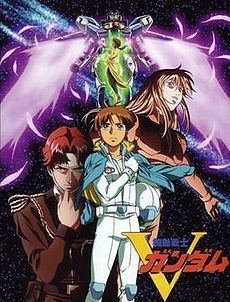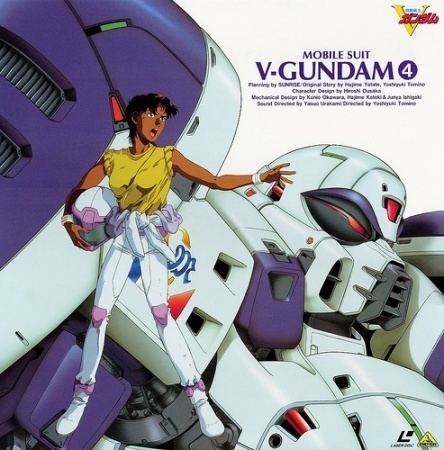7.2 /10 1 Votes
7.3/10 IMDb Studio Sunrise Final episode date 25 March 1994 Network All-Nippon News Network | 7/10 MyAnimeList 7.3/10 TV First episode date 2 April 1993 Number of episodes 51 | |||||||||||||||||||||||||||||||||
 | ||||||||||||||||||||||||||||||||||
Produced by Masuo UedaYoshiaki Koizumi Written by Akira OkeyaHideki Sonoda Cast Daisuke Sakaguchi, Kumiko Watanabe, Ayako Shiraishi Characters Üso Ewin, Katejina Loos, Shakti Kareen, Cronicle Asher, Oliver Inoe Similar Mobile Suit Gundam ZZ, After War Gundam X, Mobile Fighter G Gundam, Mobile Suit Gundam: The 08th, Mobile Suit Gundam 0080: Wa | ||||||||||||||||||||||||||||||||||
Senjuu akira awakening souls
Mobile Suit Victory Gundam (機動戦士Vガンダム, Kidō Senshi Vikutorī Gandamu, Mobile Suit V Gundam), is a 1993 Japanese science fiction anime television series. It consists of 51 episodes, and was directed by Gundam creator Yoshiyuki Tomino. The series was first broadcast on TV Asahi (and its ANN stations). It is the fourth installment in the Gundam franchise and the final full series to be set in the Universal Century calendar.
Contents
- Senjuu akira awakening souls
- Plot summary
- Development
- Music
- Release
- Novelization
- Manga adaptation
- Sequel
- Video game
- References

Plot summary

Victory Gundam is set in UC 0153, and succeeds the Federation and Crossbone Vanguard conflict of Mobile Suit Gundam F91. The Earth, still loosely controlled by the greatly weakened Earth Federation, comes under attack by BESPA, the armed forces of the space colony-based Zanscare Empire. Only a ragtag resistance movement, League Militaire, stands in BESPA's way as they swiftly conquer much of space and start their invasion of Earth, with the advanced mass-produced mobile suit, the Victory Gundam, as the League Militaire's secret weapon. However, BESPA's power continues to grow, using violent means, including public executions with guillotines, to strike fear into those living on Earth.

Living peacefully on Earth in the remote Eastern European town of Kasarelia, 13-year-old Üso Ewin and his childhood friend Shahkti Kareen are soon thrown into the conflict when they encounter ace BESPA pilot Chronicle Asher. Soon, Üso finds himself joining forces with Marbet Fingerhut and the rest of the League Militaire, piloting the Victory Gundam against the BESPA, and soon discovering the horrors of war.
Development

Victory Gundam is the fourth Gundam television series and the first of four Gundam television series that aired on TV Asahi and its sister ANN stations in Japan sequentially from 1993 through 1996. In order to attract the younger elementary school age demographic that SD Gundam was popular with at the time, the show featured the youngest protagonist in the Gundam franchise, the thirteen-year-old Uso Ewin, and established a setting within Universal Century that was largely independent of previous Gundam works. Unlike previous Gundam series that started off in space colonies, the show starts off in Eastern Europe before moving to space 15 episodes later. The intent of this was for Tomino to dispel the association between Gundam and space. Nonetheless, the mature themes of the show, as well as the high casualty rate of the main cast, meant that the show would instead attract an older crowd, the young adults who had seen Mobile Suit Zeta Gundam and Mobile Suit Gundam ZZ a decade earlier.
The show was nonetheless able to more than double the sales of "real" Gundam models, which had been greatly lagging behind SD Gundam model sales. As SD Gundam model sales had been in a decline, Bandai's Gundam toy sales ultimately increased as a result of the show, but still missed its targets of 10 million units sold. This compounded with the fact that the show had failed to attract its target audience led to a cancellation of Sunrise's next Gundam series, which was under production at the time and was to be a war story featuring a conflict between Earth and Mars colonists, with a working title of Polca Gundam (ポルカガンダム). Instead, Sunrise would go on to create Mobile Fighter G Gundam.
The Bandai acquisition of Sunrise was also in the planning stages during Victory Gundam's development, with the former looking to address the declining popularity of the Gundam franchise, which was a main source of revenue for them. Years later, Tomino would lament the fact that he had started production of this series not aware of that situation, which caused a rift between the director and Sunrise for many years.
Music
Openings:
Endings:
Soundtrack: Akira Senju
Release
The entire series was released on DVD in Japan on January 23, 2004. The limited-edition DVD box release was notable for containing an interview of Tomino titled, "This DVD should not be bought as it is not intended to be seen!!" (「このDVDは、見られたものではないので買ってはいけません!!」). Interestingly, Tomino has also made a similar comment on a Mobile Suit Zeta Gundam DVD interview.
Years after the show was first broadcast in Japan, the show aired on the anime satellite television network, Animax, in Japan and later its respective networks worldwide, including Hong Kong, Southeast Asia, East Asia, and other regions.
In 2015, Sunrise released Victory Gundam on Blu-Ray in two box sets using a new HD master and telecine. The sets also included audio commentary, exclusive booklets, and cover art by mechanical designer Hajime Katoki. As with the DVDs, Tomino reiterated his disdain for the series in promotional materials, claiming that he wished to "deny [the show] completely" and asked that viewers of the set "find what went wrong with 'Mobile Suit V Gundam'."
In 2016, Sunrise released the series on both Blu-ray and DVD in North America via Right Stuf Inc. in two sets.
Novelization
A series of five novels were written by director Yoshiyuki Tomino and initially published under the Kadokawa Sneaker Bunko label. This adaptation generally follows the plot of the anime but is notable for additional scenes and dialogue that contain graphic sexual references. In addition, the Victory 2 Gundam does not appear in the novel. Instead it is replaced by a Victory-type with a mounted Minovsky Drive. "Bugs", the automatic manslaughtering weapons of Gundam F91, also make an appearance.
Manga adaptation
A more lighthearted manga adaptation of the anime by Toshiya Iwamura was published on the Comic BomBom manga magazine. The serious atmosphere from the show was absent from the manga, replaced by gags, less serious personalities, and more super robot-style action scenes.
Sequel
A sequel to the series by Yuichi Hasegawa, Mobile Suit Victory Gundam Outside Story (機動戦士Vガンダム外伝, Kidō Senshi Vikutorī Gandamu Gaiden), also titled Mobile Suit Victory Gundam Outside Story: Escape Plan Edition (機動戦士Vガンダム外伝 脱出計画編, Kidō Senshi Vikutorī Gandamu Gaiden Dasshutsu Keikaku-hen) and Mobile Suit Victory Gundam Project Exodus (機動戦士Vガンダム プロジェクト・エクソダス), was published in 1994 in the Shōnen Kids magazine. The manga occurs during the events of the anime, when Uso travels to Jupiter and encounters an old man by the name of Grey Stoke.
Video game
A Super Famicom side-scrolling action game was released in Japan. It was developed by Bandai Games.
